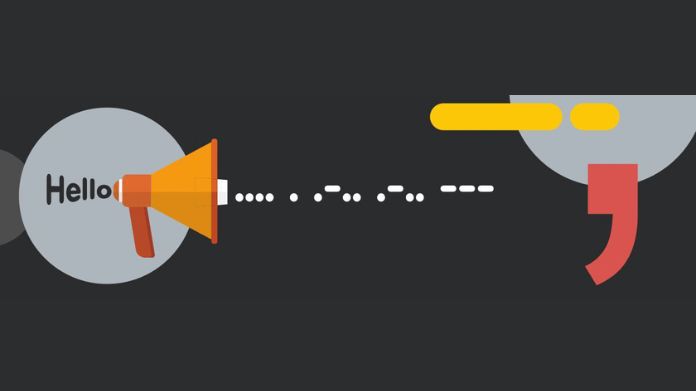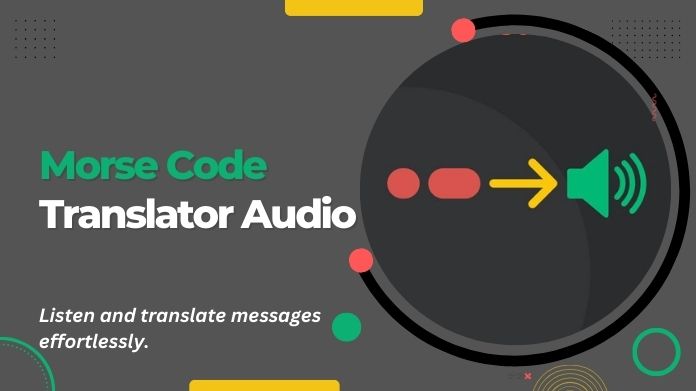Communication history has been dramatically influenced by Morse code, a text-transmission technique that uses a series of dots and dashes.
Created by Samuel Morse and Alfred Vail in the early 1800s, it was utilized for long-distance telegraph communication. Even nowadays, Morse code is still necessary for amateur radio operators, and enthusiasts worldwide are still fascinated by it.
This extensive guide will delve deeply into Morse code translator audio, examining its foundations, guiding principles, and valuable applications.
To improve your learning experience, we will review Morse code’s fundamentals, explain how to decode and encode it, and even look into Morse Code Translator Audio.
A Brief Overview of Morse Code

Text characters can be encoded as short and long signals or as dots and dashes using the Morse code technique. A distinct set of these signals corresponds to each character.
One way to represent the letter ‘A’ is “.-” and the letter ‘B’ is “-…” Timing is a concept used in Morse code, where a dash (-) denotes a long signal, and a dot (.) represents a short signal.
Generally speaking, a dash lasts three times as long as a dot. The revolutionary development of Morse code transformed long-distance communication.
American inventor Samuel Morse and his assistant Alfred Vail created Morse code as a valuable technique for transmitting messages via telegraph wires over great distances.
The creation immediately became well-known and was crucial in various historical events, including maritime communication, military operations, and rescue missions.
The Morse Code Alphabet
In Morse code, characters, digits, and punctuation are represented by combining dots and dashes, or “dots” and “dash.” Since each character is represented uniquely, it’s a very effective and dependable communication method.
This is the alphabet in Morse code.
Letters:
- A: .- N: -. 0: —–
- B: -… O: — 1: .—-
- C: -.-. P: .–. 2: ..—
- D: -.. Q: –.- 3: …–
- E: . R: .-. 4: ….-
- F: ..-. S: … 5: …..
- G: –. T: – 6: -….
- H: …. U: ..- 7: –…
- I: .. V: …- 8: —..
- J: .— W: .– 9: —-.
- K: -.- X: -..-
- L: .-.. Y: -.–
- M: — Z: –..
Morse Code Timing
When communicating via Morse code, Timing is essential. The basic unit of time is usually defined as the duration of a dot (. ), and a dash (-) is three times that of a dot.
One dot separates elements of the same character, but three dots separate two characters in the same word. Seven dots separate two words.
How to Decode Morse Code Using Morse Code Translator Audio?

The following tools and equipment are required to decode audio in Morse code.
Requirements of Equipment and Tools
Audio Source: A radio receiver, a smartphone app, or an internet Morse code generator are examples of an audio source that can play Morse code signals.
Speaker or Headphones: To hear the Morse code audio, use a speaker or a set of headphones.
Morse Code Chart: A reference guide or Morse code chart to aid signal interpretation.
Steps to Decode Morse Code Audio
Follow these steps to decode Morse code audio.
Pay Close Attention: Listen carefully to the audio in Morse code. Dashes and dots will be heard as long and short sounds.
Character Recognition: Use the Morse code chart to identify each character by listening to it. For instance, “A” is a short sound followed by a long sound, and “H” is a long sound followed by three harsh sounds.
Decode Words: After identifying the characters, translate them into words. Remember to leave the proper spacing between characters and words per the mentioned timing guidelines.
Practice: Practice is necessary to decode audio in Morse code. Work your way up to more complex messages by starting with simpler ones.
How to Encode Morse Code Using Morse Code Translator Audio?
The following tools and equipment are required to encode Morse code into audio signals.
Requirements of Equipment and Tools
Morse Code Key: To manually generate Morse code signals, one needs a Morse code key, also known as a telegraph key. Making dits and dahs usually consists of a lever or button you can press.
Audio Output Device: To hear the Morse code signals produced, you’ll need an audio output device, like a speaker or headphones.
Steps to Encode Morse Code Audio
Follow these steps to encode Morse code into audio.
Configure Your Morse Key: Attach your audio source to your Morse code key. Ensure the telegraph key is correctly connected and operating if you’re using one.
Learn Morse Code: Become acquainted with the character sequences corresponding to each character in Morse code.
Write the Message: Choose the message you wish to convert into Morse code. For beginners, start with essential words and phrases.
Create Morse Code: Use the Morse key to generate the Morse code manual signals for each character in your message. Remember to time your dots and dahs correctly.
Send the Message: The audio output device will playback the Morse code signals as you produce them. Anyone listening to the audio can hear this.
Conclusion
Even today, Morse code is a historically significant and fascinating communication technique. Whether you want to encode messages or audio signals in Morse code, this guide has given you the essential information and steps to get started with Morse Code Translator Audio.
Keep in mind that mastering Morse code requires practice. As you gain experience, you can experiment with more complex methods and even participate in Morse code competitions or amateur radio operations.
Accept the history of Morse code and never stop appreciating its unique position in the communication industry.
Enjoy your encoding and decoding!
